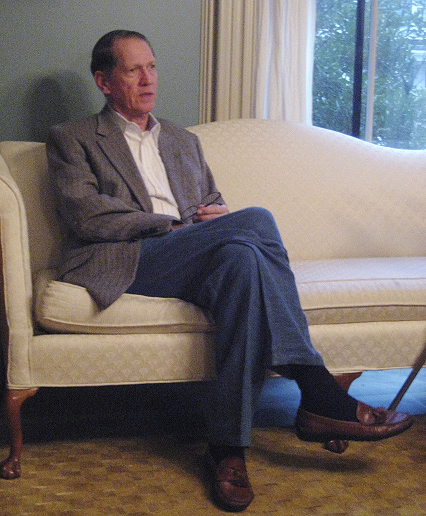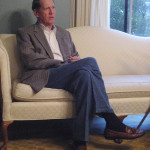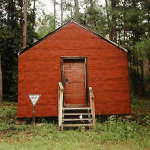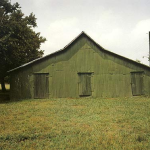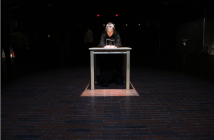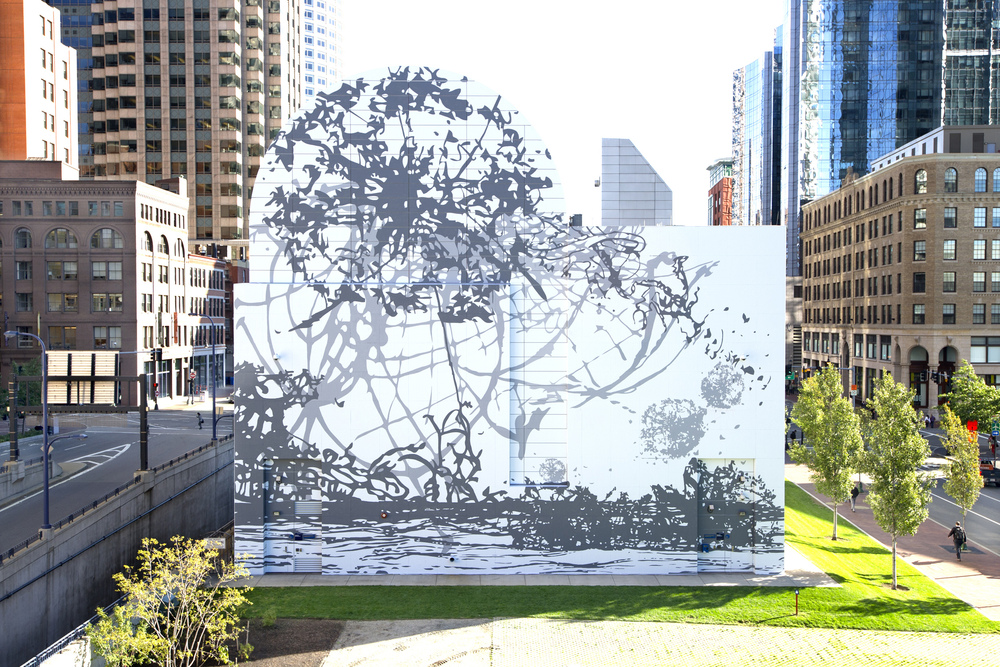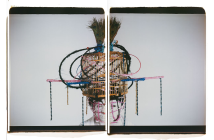AN INTERVIEW WITH WILLIAM CHRISTENBERRY
William Christenberry is a multi-media artist whose themes relate to his Southern upbringing. Born in 1936 and raised in Hale County, Alabama, this is the very county made famous by James Agee and Walker Evans’ seminal book, Let Us Now Praise Famous Men. Known best for his small format and 8x10 photographic images of the South, Christenberry has returned annually to Hale County to make his photographs. Since 1968, he has taught at the Corcoran College of Art and Design and lived in Washington D.C.
On occasion of his latest show, a traveling exhibition organized by Aperture, currently on view at the Massachusetts College of Art and Design, Christenberry spoke with Big Red writer Ben R. Sloat.
Ben R. Sloat: Your images are very much about changes in the South, of your hometown in Hale County, Alabama. I’m wondering if you see the camera as a way to preserve, to keep what was once there or do you see it as a witness for change happening?
William Christenberry: My work is often confused with being nostalgic. The work is not nostalgic for something gone or passing, or in the process of change, but I am fascinated with how things do change and with vernacular architecture. I call it the “architecture of my childhood”: the dogtrot or breezeway house, country stores…there are so few left. I have fond memories but I would like to say that nostalgia is not the main thing. You can wallow, if you know what I mean. Let me also emphasize that the camera was not my main means of expression at that time, nor is it today. It’s mostly been painting or sculpture but photography became a vehicle to record, to preserve some of the things that are bygone. Even in the last twenty years I’m hard pressed to find subject matter that interests me.
BRS: Along those lines, you can make a parallel with the work of Eugene Atget, making photographs for painters to use as backdrops. Is there an identity of the South you’re trying to capture, is that too complex of a thing to define?
WC: I think certain Southern writers high on my list have contributed: Mr. Faulkner, Flannery O’Connor, Eudora Welty, and in more recent times, Walker Percy and many others, but we (Southerners) were not thought of as a visual artists. This has happened more in my lifetime, where people began to think things in the landscape have some interest or beauty. I don’t want to make too much of this, but the use of that little camera, for the beginning, was just the most straightforward response to that landscape. I would often make sketches of the buildings I was photographing, It pleases me that now those little 3” x 5” photographs are a record of something that’s going fast.
As time went on, I had quite a few photographer friends. The first person to encourage me to take those little Brownie snapshots was Walker Evans himself. When he saw those in New York in 1962 he said: “young man, there’s something about the way you use this little camera that’s become a perfect extension of your eye. I suggest you take these seriously.”
Well I had a really hard head! It meant a lot coming from him, but I don’t think I fully understood it at the time. Evans had said early on: “color photography’s vulgar but there’s something about this lens (of the Brownie), the lack of sharpness, that makes the color just right.”
BRS: I’m struck by the human stories each of the images seem to contain, a trace of a person: the woman who made the egg carton crosses, the people who painted their houses only up to where they could reach…You’re not really making portraits of people, but maybe portraits of a culture, a society.
WC: I like that, I think you’re absolutely right. I never felt comfortable photographing people. Even Sandy’s and my children, who are grown now, or our grandchildren, I don’t make pictures of them. I can make a decent snapshot of them playing, but it doesn’t resonate with me as much as the human touch on a building, on a grave, on an egg carton cross, that has a certain wonderment for me as an artist.
BRS: In term of that human touch you mention, the same can be said of the sculptures you’ve made of buildings, which is your touch and the time you spend to build them. Could you talk a little bit about that transition to sculpture and what those do as opposed to what the photographs do.
WC: I’m pleased of the exhibitions here, the ones put together by Aperture that we’re going to see tonight, and I’m not faulting anybody, but I think it would be extremely helpful to include the building constructions, as I call them. I don’t call them models because they’re not models to me. I don’t have a scale to go by or a floorplan, they’re all by eye. They might look like, or hopefully have the feeling of the building that was once in the landscape.
There’s something about the little camera, I don’t know if I’ve been successful with it, but it has represented a pretty good aesthetic in terms of my feeling about the place. It was that desire, that need, and the camera seemed to be the tool, the device, to record that which I’ve really had a love affair with.
BRS: I’m interested in how you return back to Alabama yearly. You don’t hear too much of photographers retracing their steps to observe changes.
WC: This was not a planned thing, this was an evolving thing. Our children are grown now, but when my parents were alive, living in Alabama, we wanted them to have contact with their grandparents and other relatives. It was just natural thing to make photographs of those things in the landscape.
Interesting point, I have made a trip back every year since ’68, without fail, sometimes if I had to give a lecture or talk, I might get to go back in the fall, or in the winter. Then in the seventies, ’77 I think, some of my photographer friends, Nick Nixon in particular, and to some degree Eggleston and Friedlander said: “Wouldn’t be interesting to see what Christenberry might do with a sophisticated camera!” So I had to learn on the job, never exposed a sheet of film before. I had a professional photographer load the film, slide in the holders, so I got lucky. And they were in focus! And they weren’t bad!
When they were first exhibited, we had them printed onto 20” x 24” paper, that was considered a pretty big picture. Nowadays, we live in a day of big, big, big pictures, but I’m not being critical.
BRS: Do you think the limitation of being in Alabama only once a year, or twice a year, gave you a different perspective than if you were there all the time?
WC: Good question. I don’t think if I lived there all the time that I would see it the way I do. I see my work as highly subjective, it’s a total involvement with that place, that light, that situation, etcetera etcetera. Some people find that whole statement rather pretentious.
BRS: …that the work is about yourself, ultimately? Evans talks about Atget’s work being a projection of himself onto old Paris.
WC: That’s a very good parallel and I’ve always admired, for many many years, the work of Atget. And precisely that. Paris, his environment.
BRS: I’m interested in the multimedia aspects of your work.
WC: Yes, don’t leave that out sir! I’ll continue to have exhibitions, I hope, like what’s here, and there’s some found objects in the exhibition, signage. Ideally, it’s the whole range of work. There’s another show that originated at the Smithsonian in Washington, it’s not a retrospective but it’s a big show and some of the sculptures are eight feet high. It’s worked out very well, People will come up to me and say “I had no idea you did so many things.” They’ll know the sculpture or the painting, and didn’t know the photographs, or vice versa.
BRS: Could you speak a little bit about your interest in Duchamp?
WC: That’s good question, even as a student, in the 1960s at the University of Alabama, I became interested in Surrealism and Dadaism. Dadaism came first, Surrealism was often called: “Dada’s sawed-off-side.” The philosophy of it (interested me). Dadaism had a social significance, because of World War I: chaos in this world, madness, irrationality, so on and so forth. One of the leaders in that movement was Marcel Duchamp. I would go to the library at the University of Alabama and they had a lot of wonderful books on Dada, especially Duchamp. I never looked at Duchamp as an influence in terms of his actual works but his philosophy, yes, most definitely.
- William Christenberry in conversation with Ben R. Sloat last October
- William Christenberry, Red Building in Forest, Hale County, AL, Ektacolor print, 1994
- William Christenberry, Green Warehouse, Newbern, AL, Ektacolor print, 1978
Massachusetts College of Art
Pace/MacGill Gallery
"William Christenberry Photographs, 1961 - 2005" is on view at the Sandra and David Bakalar Gallery at Massachusetts College of Art (621 Huntington Ave., Boston) until December 6.
All images are courtesy of the artist and Pace/MacGill Gallery.

